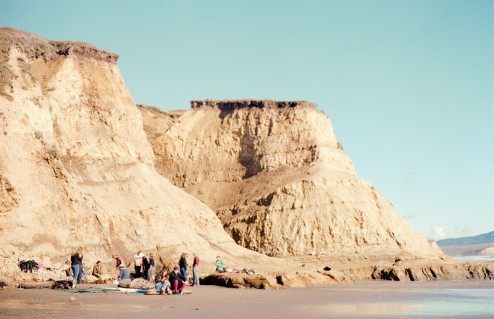Behind the scenes of the bioregional Fibershed wardrobe is a thriving community of designers, farmers, ranchers, natural dyers, and ethnobotanists. One of the tenets of our project since the beginning has been to hold celebrations, in honor of the contributions of the project’s supporters. Some have knit sweaters, some have donated personal finances, while others have cared for their flocks and tended their fields, providing wool and cotton for the garments.
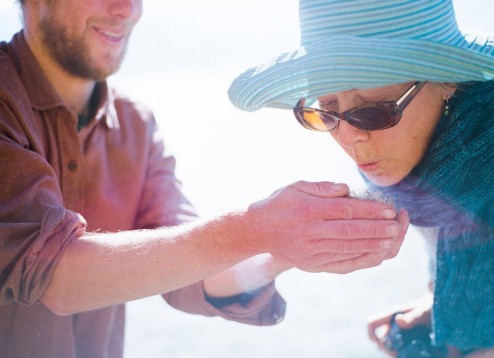
The morning began with a set of interesting factors that had us seriously wondering wether our celebration was going to happen– including a high tide that erased all vestiges of the beach, and a small pod of sleeping elephant seals– who preferred their nap-time remain uninterrupted. We did find a small alcove, and within hours, it became a perfect setting for the days activities… record high tides, are followed by record low tides– we had this on our side.
Jay Sliwa (seen above on the left) started the morning with a fire ceremony. He asked us to kindly focus our intention on the fire, and support the process as he, and our mutual friend, Katherine Jolda methodically and rapidly turned the fire rod in their palms….back and forth– friction igniting coal.
 Once the fires were started– a pot of native toyon, native sagebrush, and two pots of seawater were put onto the heat, and began their journey towards boiling. Seawater has trace elements of aluminum, (only about 8ppb), however there are many qualities to seawater that have the potential for being useful as mordants. An aspect of our celebration was to dive into the realm of experimentation– and work together to see what we could manifest with the most local and benign materials.
Once the fires were started– a pot of native toyon, native sagebrush, and two pots of seawater were put onto the heat, and began their journey towards boiling. Seawater has trace elements of aluminum, (only about 8ppb), however there are many qualities to seawater that have the potential for being useful as mordants. An aspect of our celebration was to dive into the realm of experimentation– and work together to see what we could manifest with the most local and benign materials.
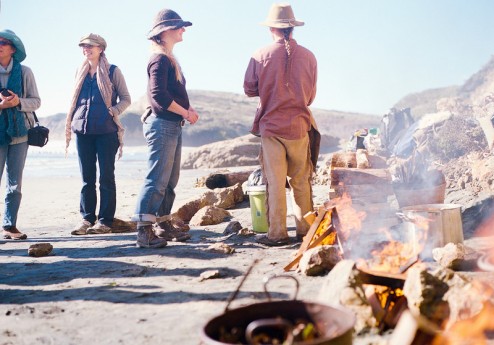
The toyon and sagebrush were poured into old copper vessels, and the ocean water was poured into 5 gallon stainless steel vats.
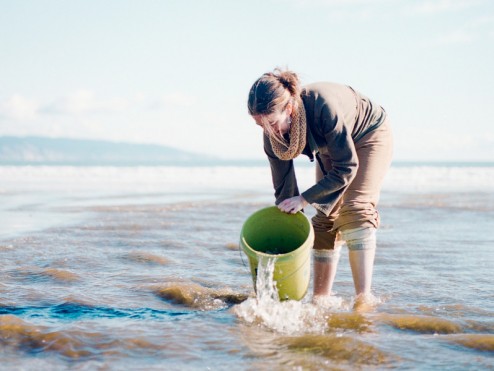
Water was captured and carried across the expanses of sand, and then poured fresh into our pots.
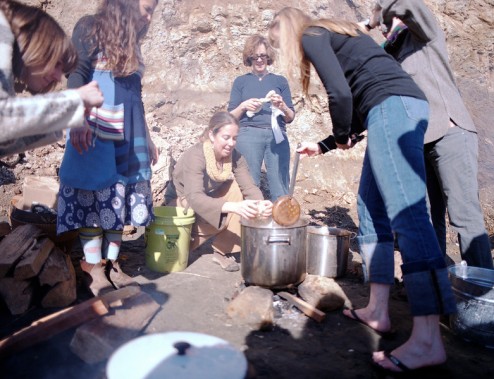
Most of our samples were doused in the sea water before entering into the sage and toyon dye vats. The potential for more than one mordant to be reacting with the fiber was highly likely. Toyon and sage both contain a certain level of tannin (toyon has high quantities), and this compound also functions as a binding agent for color. We were also using copper pots, which leach into the water, adding metallic compounds to our experiment… yet another binding agent.
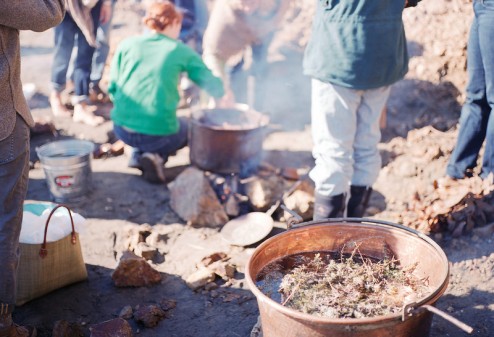
If we wanted to soley identify the potential and potency of sea water as a mordant, we would have used less tannin rich plant species, and stainless steel or enamel pots for all of our work… however, the copper vessels are the largest that I own, and were well suited for our group endeavors.
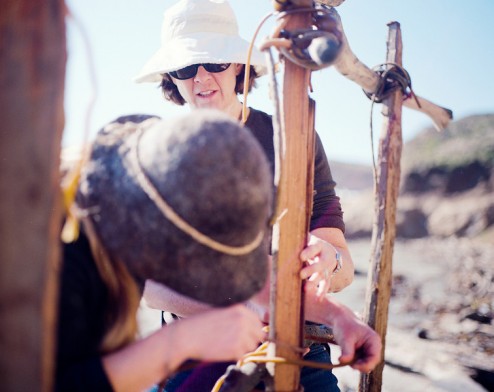
Our dry rack was constructed by the swift hands of Sue (expert jeweler and knitter), and Katherine (professional felter). It was built from drift wood and seaweed… the final construction reminisced of fine art–a pure form of sculpture.
The entirety of our day was a work of art. Including Molly de Vries‘s offering of tea, that she brought to us along with her homemade cups.
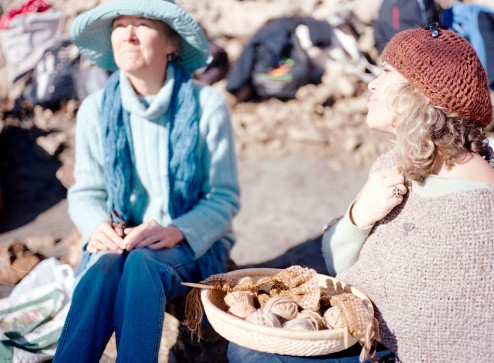
Dustin and Molly sit absorbing the first sunlight that any of us had seen in days. After many rainstorms, we were all elated to be outside in the warm and temperate seaside air.
Adam sits on the ochre rocks, pole-wrapping his cloth around a kelp branch. We used found objects as sources for resisting the dye.
Sally Scopa is an intern for the Fibershed project, visiting here from the East Coast. The project is blessed to have her participation. Here, she prepares her fabric through folding it like a fan.
Amber Elandt wears her hand-constructed moccasins, enjoying the detail work of her shibori process.
The pieces began to emerge from the toyon vat… the reddish, orange and pinky tones were created with the leaves and branches. The plant matter soaked for several days before arriving to our day of dyes.
A shirt wrapped in kelp was slowly unwound after being pulled from the dye vat.
The toyon vat steams as the hot coals and embers beneath keep the water at a low simmer.
Local Mill Valley Yarns from Kenny Kirkland’s farm hang on the dry rack with fabric swatches.
The sculpted drying station comes alive with native plant color, and the effects of the sea water mordant processes.
Molly begins the process of kelp basket weaving, a project that many began to join in on.
Ellery Burgess shares in the weaving process.
The story of our fibershed community celebrations continue…. we are already looking forward to our next gathering.. and we look forward to sharing it with our online community.. thank you for reading and sharing this journey with us.
I would like especially thank my amazing brother Michael Keefe for taking all of these amazing pictures!!
For more images of our day go to: Mike Keefe

